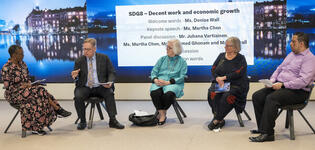Blog
The COVID-19 crisis, informal workers, and gender — understanding the intersections
The COVID-19 crisis — the pandemic, restrictions, and recession — has not been a grand leveler. While all of us, rich and poor, faced the fear and uncertainty of the virus, the crisis has exposed and amplified pre-existing inequalities, injustices, and insecurities. Depending on their positionality and perspective, some observers focus on the disproportionate impact that the crisis has had on women while others focus on the disproportionate impact that the crisis has had on the working poor or poor more generally.
For example, surveys conducted in late April 2020 in Burkina Faso, Mali, and Senegal found that informal workers were far less likely to be able to work than formal workers. The authors attributed this to the fact that informal workers were disproportionately impacted by lockdown measures. A special issue of Feminist Economics on the COVID-19 crisis argued that it is women who are overrepresented in most of the hardest hit sectors — such as hotel and food services, retail trade and labour-intensive manufacturing — which ‘translated into larger declines in employment for women than men in numerous countries’. Both studies identified retail, hotel, and food services among the hardest hit sectors.
Both perspectives are correct: as both informal workers and women are overrepresented in many of the sectors which were badly hit by the COVID-19 crisis. The reality is more complex. An 11-city study on the impact of the COVID-19 crisis on informal workers (both women and men) can help to interpret and reconcile these seemingly different perspectives. This longitudinal study, led by the WIEGO Network, was conducted in both mid-2020 and mid-2021, with April 2020 (peak lockdowns and restrictions across all cities) and February 2020 (pre-COVID base line) as comparative reference periods.
The 11 cities studied were from nine countries in five geographic regions (Africa, Asia, Eastern Europe, Latin America, and North America). The indicative sample was drawn primarily from four groups of informal workers of which two were predominantly women (domestic workers and home-based workers) and two were comprised of both women and men (street vendors and waste pickers).
The main findings
The study shows that COVID-19 caused a significant negative impact on the work and earnings of informal workers, both women and men. Worker earnings have recovered very slowly — by mid-2021, the typical informal worker was earning only two-thirds of their pre-COVID earnings. There are significant differences among informal workers, too, by sector and within sectors, by status in employment, place of work, product/service, and between women and men.
Differences between sectors
- Waste pickers were the most able to work during the crisis, followed by domestic workers, and experienced the biggest recovery of earnings, albeit from the second lowest pre-COVID base
- Street vendors/market traders ranked third in terms of ability to work and in recovery of earnings by mid-2021.
- Home-based workers were the least able to work across all periods of time during the crisis and experienced the least recovery of earnings by mid-2021, from the lowest pre-COVID base.
Differences within sectors
- Live-in domestic workers fared better than live-out domestic workers, but often had to work longer hours and were not allowed to visit their families
- Self-employed home-based workers fared better than sub-contracted home-based workers who depend on orders from supply chains
- Street vendors and market traders who sold food items fared better than those who sold non-food items, especially during the peak lockdowns and restrictions in 2020.
- Waste pickers who collected waste at dumpsites fared worse than those who collected from households or the streets
Differences between women and men
- Women were overrepresented among home-based workers who suffered the greatest decline and experienced the least recovery in work and earnings. But women were also overrepresented among domestic workers who suffered least, after waste pickers, and recovered most
- Men street vendors/market traders fared better, on average, than women street vendors/market traders, for a variety of reasons, including greater access to vending sites, work permits, and working capital, and less harassment by police and local authorities.
- Men waste pickers fared better than women, on average, for a variety of reasons including greater physical strength required to compete for and transport waste and less harassment by police and local authorities
- Both women and men informal workers reported that government restrictions, disruptions in supply chains and markets, and health concerns were the main factors which restricted their ability to work and earn
- But a higher percentage of women informal workers reported care and other household responsibilities and the lack of public transport as additional factors which prevented their ability to work and earn.
In sum, not all informal workers, not even all women informal workers, were equally impacted by the COVID-19 crisis. These findings point to the need for intersectional analysis to determine and understand the impact of the crisis — and wider economic trends and policies — on women versus men workers by first interrogating the impact on informal workers versus formal workers, then on different groups of informal and formal workers and finally, within these groups, by sex. Applying an intersectional lens also allows us to understand the factors and dynamics underlying these patterns.
Marty Chen is Chairperson of the UNU-WIDER Board, Lecturer in Public Policy at the Harvard Kennedy School, and a founding member and Senior Advisor of Women in Informal Employment: Globalizing and Organizing (WIEGO). Her research, experience, and insights have been invaluable to development scholarship for decades.
The views expressed in this piece are those of the author(s), and do not necessarily reflect the views of the Institute or the United Nations University, nor the programme/project donors.
 Join the network
Join the network










